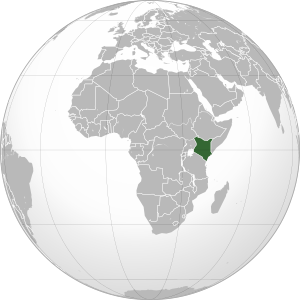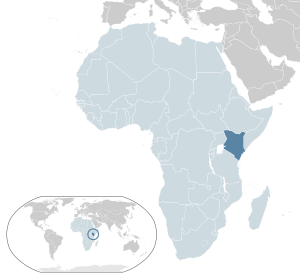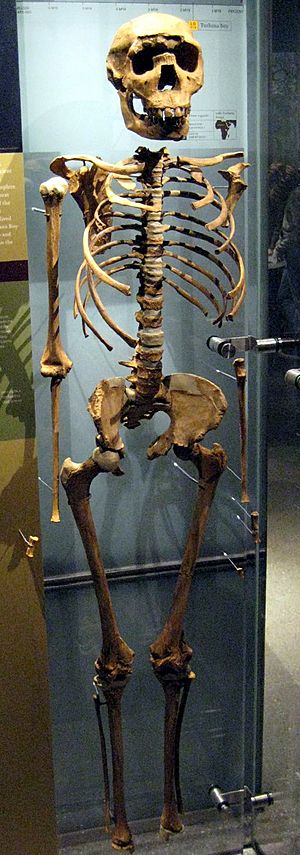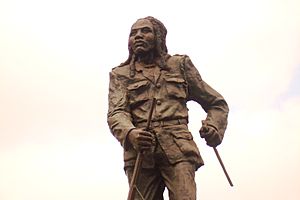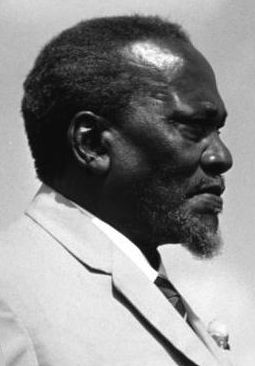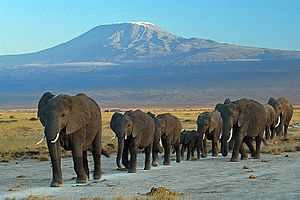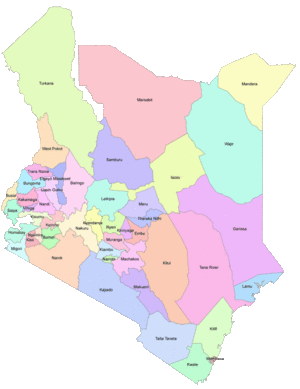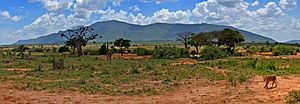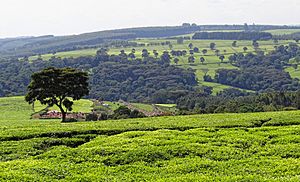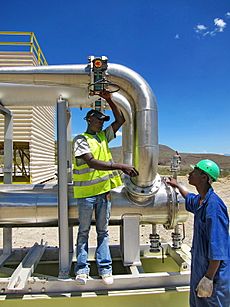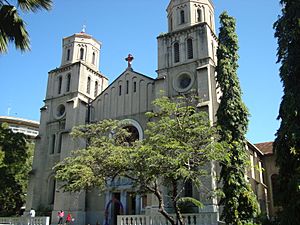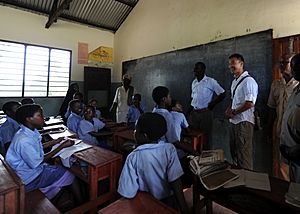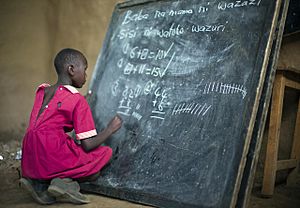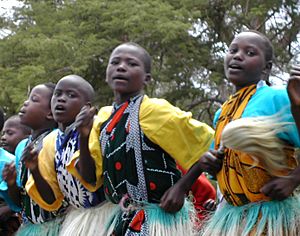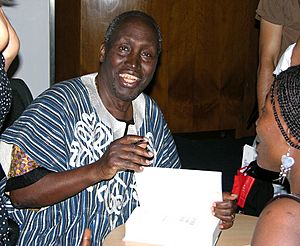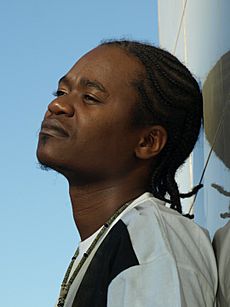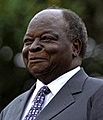Kenya facts for kids
Quick facts for kids
Republic of Kenya
Jamhuri ya Kenya (Swahili)
|
|
|---|---|
|
Motto: "Harambee"
("Let us all pull together") |
|
|
Anthem: "Ee Mungu Nguvu Yetu"
("O God of All Creation") |
|
| Capital and largest city
|
Nairobi 1°16′S 36°48′E / 1.267°S 36.800°E |
| Official languages | |
| National language | Swahili |
| Ethnic groups
(2019 census)
|
|
| Religion
(2019 census)
|
|
| Demonym(s) | Kenyan |
| Government | Unitary presidential republic |
| William Ruto | |
| Vacant | |
|
• Senate Speaker
|
Amason Kingi |
| Legislature | Parliament |
| Senate | |
| National Assembly | |
| Independence | |
|
• Portuguese exploration
|
1498 |
|
• Omani control of Swahili coast
|
1698–1887 |
|
• Dominion
|
12 December 1963 |
|
• Republic
|
12 December 1964 |
|
• Current Constitution
|
27 August 2010 |
| Area | |
|
• Total
|
580,367 km2 (224,081 sq mi) (48th) |
|
• Water (%)
|
2.3 |
| Population | |
|
• 2024 estimate
|
52,428,290 (28th) |
|
• 2019 census
|
47,564,296 |
|
• Density
|
82/km2 (212.4/sq mi) (124th) |
| GDP (PPP) | 2023 estimate |
|
• Total
|
|
|
• Per capita
|
|
| GDP (nominal) | 2023 estimate |
|
• Total
|
|
|
• Per capita
|
|
| Gini (2021) | ▼ 38.7 medium |
| HDI (2022) | medium · 146th |
| Currency | Kenyan shilling (KES) |
| Time zone | UTC+3 (East Africa Time) |
| Date format | dd/mm/yy (AD) |
| Driving side | left |
| Calling code | +254 |
| ISO 3166 code | KE |
| Internet TLD | .ke |
|
According to the CIA, estimates for this country explicitly take into account the effects of mortality because of AIDS; this can result in lower life expectancy, higher infant mortality and death rates, lower population and growth rates, and changes in the distribution of population by age and sex, than would otherwise be expected.
|
|
Kenya, officially known as the Republic of Kenya (Jamhuri ya Kenya in Swahili), is a country located in East Africa. It is home to over 47.6 million people, making it the 28th most populated country in the world. It is also the 7th most populated country in Africa.
Nairobi is Kenya's capital and largest city. Mombasa is the oldest and second-largest city, located on the coast. It was Kenya's first capital until 1907. Kisumu is the third-largest city and an important port on Lake Victoria. This lake is a hub for transport, fishing, farming, trade, and tourism.
Kenya is the third-largest economy in sub-Saharan Africa, after Nigeria and South Africa. It shares borders with South Sudan to the northwest, Ethiopia to the north, Somalia to the east, Uganda to the west, and Tanzania to the south. The Indian Ocean lies to its southeast. Kenya has a wide variety of landscapes, from cold, snow-capped mountains like Mount Kenya to vast forests, wildlife areas, and fertile farms. It also has warmer regions in the west and dry, desert areas like the Chalbi Desert.
The first people in Kenya were hunter-gatherers. Later, groups speaking Cushitic languages settled in the lowlands between 3,200 and 1,300 BC. Around 500 BC, Nilotic-speaking people who raised animals began moving into Kenya from what is now South Sudan. Bantu people settled along the coast and inland between 250 BC and 500 AD.
Europeans first arrived in Kenya around 1500 AD with the Portuguese Empire. The British Empire began to take control in the 19th century. Modern Kenya started as a British protectorate in 1895 and became the Kenya Colony in 1920. Many disagreements between the British and the colony led to the Mau Mau revolution in 1952. Kenya gained its independence in 1963 and became a republic in 1964. It is still a member of the Commonwealth of Nations. Kenya's current constitution was put in place in 2010.
Contents
- A Look at Kenya's Early History
- Kenya Under British Rule (1888–1962)
- The Mau Mau Uprising
- Kenya Gains Independence
- Kenya's First President
- How Kenya's Government Works
- Kenya's Geography and Climate
- How Kenya is Divided Up
- Tourism in Kenya
- Farming in Kenya
- Industry and Manufacturing in Kenya
- Getting Around: Transport in Kenya
- Energy in Kenya
- Kenya's Population and People
- Education System in Kenya
- Kenyan Culture and Traditions
- Sports in Kenya
- Kenyan Food and Meals
- Images for kids
- See also
A Look at Kenya's Early History
Fossils found in Kenya show that early human-like creatures lived there over 20 million years ago. Discoveries near Lake Turkana suggest that early humans, like Homo habilis and Homo erectus, lived in Kenya long ago. These species are thought to be direct ancestors of modern humans.
In 1984, a 1.6-million-year-old fossil called the Turkana boy was found near Lake Turkana. This fossil belonged to Homo erectus. Other important ancient sites in Kenya include Namoratunga, which studied ancient stars, and the walled settlement of ThimLich Ohinga.
The first people in Kenya were groups who hunted animals and gathered plants for food. Later, people who raised animals and farmed, called agropastoralists, came from the Horn of Africa. Around 500 BC, people who raised animals, like the Samburu and Maasai, started moving into Kenya from Southern Sudan.
By 1000 AD, Bantu-speaking farmers had moved into the region. They brought new ways of farming and iron working. Along the Kenyan coast, communities of ironworkers, farmers, hunters, and fishers traded with other countries. These communities formed early city-states known as Azania.
The Kenyan Coast has welcomed many traders and explorers over the centuries. Malindi has been an important Swahili settlement since the 14th century. In 1414, the Chinese explorer Zheng He visited the coast. The Portuguese explorer Vasco da Gama was welcomed in Malindi in 1498.
Kenya Under British Rule (1888–1962)
Kenya's time as a colony began when Germany set up a protectorate over the Sultan of Zanzibar's coastal lands in 1885. Then, the Imperial British East Africa Company arrived in 1888. Germany later gave its coastal areas to Britain in 1890. After this, the Kenya–Uganda railway was built through the country.
Some local groups, like the Nandi led by Koitalel Arap Samoei, resisted the railway's construction for ten years. However, the British finished the railway. The Nandi were the first group to be moved to a special reserve to stop them from bothering the railway builders.
Many Indian people came to Kenya during the railway's construction. They provided most of the skilled workers needed. Many of them and their families stayed in Kenya, forming communities like the Ismaili Muslim and Sikh groups.
During World War I, a German military leader named Paul von Lettow-Vorbeck fought against the British in East Africa. He used guerrilla warfare tactics, living off the land and capturing British supplies. He remained undefeated until after the war ended in 1918. The British brought troops from India and used many African porters to carry supplies. This experience helped many Africans become more interested in politics.
In 1920, the East Africa Protectorate became a colony and was renamed Kenya, after its highest mountain. British and other European farmers settled in the central highlands. They grew coffee and tea and became very wealthy. By the 1930s, about 30,000 white settlers lived there and had a strong political voice.
The central highlands were already home to over a million Kikuyu people. To protect their own interests, the settlers banned the Kikuyu from growing coffee. They also introduced a hut tax and gave less land to landless farmers in exchange for their work. This caused many people to move to cities. By the 1950s, there were 80,000 white settlers in Kenya.
During World War II, Kenya provided many workers and farm products for the United Kingdom. There was also fighting in Kenya between Allied forces and Italian troops in 1940–41.
In 1952, Princess Elizabeth was visiting Kenya when her father, King George VI, passed away. She immediately returned home to become Elizabeth II. It is said that she went up a tree in Africa as a princess and came down a queen.
The Mau Mau Uprising
From October 1952 to December 1959, Kenya was in a state of emergency. This was because of the Mau Mau rebellion against British rule. The Mau Mau, also known as the Kenya Land and Freedom Army, were mainly members of the Kikuyu group.
The British governor asked for British and African troops, including the King's African Rifles. The British began operations to stop the rebellion. In May 1953, General Sir George Erskine took charge of the armed forces with support from Winston Churchill.
The capture of Warũhiũ Itote, also known as General China, in January 1954 helped the British understand the Mau Mau's leadership better. A big operation called Operation Anvil started in April 1954. It put Nairobi under military control. People in Nairobi were checked, and Mau Mau supporters were sent to detention camps. By the end of the emergency, 4,686 Mau Mau fighters had been killed.
The capture of Dedan Kimathi in October 1956 marked the end of the Mau Mau's military fight. During this time, the government made big changes to land ownership. The Swynnerton Plan was used to reward those loyal to the British and punish Mau Mau supporters.
Kenya Gains Independence
The first direct elections for native Kenyans to the Legislative Council happened in 1957. The Kenya African National Union (KANU), led by Jomo Kenyatta, formed a government. Kenya became an independent country on December 12, 1963.
Exactly one year later, on December 12, 1964, Kenya became a republic called the "Republic of Kenya."
At the same time, the Kenyan army fought the Shifta War against ethnic Somali rebels. These rebels wanted to join their relatives in the Somali Republic. A ceasefire was reached in October 1967. To prevent future invasions, Kenya signed a defense agreement with Ethiopia in 1969, which is still in effect.
Kenya's First President
On December 12, 1964, Jomo Kenyatta became Kenya's first president. During his time as president, Kenyatta and his family became very wealthy by buying a lot of property. This made many landless Kenyans angry. His family used his position to get land and invested in hotels along the coast. Kenyatta himself owned the Leonard Beach Hotel. He was president until he passed away on August 22, 1978.
How Kenya's Government Works
Kenya is a presidential representative democratic republic. This means the president is both the head of state and the head of government. The government carries out the laws. The National Assembly and the Senate make the laws. The Judiciary (courts) works independently from the government and lawmaking bodies.
Kenya's Geography and Climate
Kenya covers about 580,367 square kilometers (224,960 square miles). This makes it the 47th largest country in the world. It is located between 5°N and 5°S latitude, and 34° and 42°E longitude. From the Indian Ocean coast, the land rises to central highlands. These highlands are split by the Great Rift Valley. Fertile flat areas are found on both sides, around Lake Victoria and to the east.
The Kenyan Highlands are one of Africa's best farming regions. They are home to Mount Kenya, the second-highest peak in Africa, reaching 5,199 meters (17,057 feet). Mount Kilimanjaro (5,895 meters or 19,341 feet) can be seen from Kenya, just south of the Tanzanian border.
Kenya's Climate Zones
Kenya's climate changes across the country. It is tropical along the coast, temperate inland, and dry in the north and northeast. The country gets a lot of sunshine every month. At higher elevations inland, nights and early mornings are usually cool.
The "long rains" season is from March/April to May/June. The "short rains" season is from October to November/December. Rainfall can be heavy, often happening in the afternoons and evenings. Climate change is affecting these rain patterns, causing more floods and more frequent droughts.
Temperatures stay high during the tropical rain months. The hottest time is February and March, just before the long rains. The coldest time is in July, lasting until mid-August.
Amazing Wildlife in Kenya
Kenya has large areas set aside for wildlife. This includes the Masai Mara, where over a million wildebeest and 200,000 zebras take part in a huge yearly migration. They cross the Mara River in search of food and water.
The "Big Five" game animals of Africa—the lion, leopard, buffalo, rhinoceros, and elephant—can all be found in Kenya, especially in the Masai Mara. Many other wild animals, reptiles, and birds live in the country's national parks and game reserves. This annual animal migration, which attracts many tourists, happens between June and September. Two million wildebeest travel 2,900 kilometers (1,800 miles) from the Serengeti in Tanzania to the Masai Mara in Kenya. This migration is one of the Seven Natural Wonders of Africa.
How Kenya is Divided Up
Kenya is divided into 47 semi-independent counties, each led by a governor. These counties are the main divisions of Kenya.
The smallest local government units are called locations. They are often named after their main villages or towns. Each location has a chief appointed by the state.
Constituencies are areas for elections. Each county has a certain number of constituencies. Before the 2013 elections, Kenya had 210 constituencies.
Tourism in Kenya
Tourism in Kenya is the second-largest source of income for the country, after agriculture. The Kenya Tourism Board provides information about tourism in Kenya.
The main attractions are photo safaris in the 60 national parks and game reserves. Other popular spots include the wildebeest migration at the Masaai Mara, which is called the 7th wonder of the world. Historic mosques and old forts can be found in Mombasa, Malindi, and Lamu. Beautiful scenery like the snow-capped Mount Kenya and the Great Rift Valley also draw visitors. Tea farms at Kericho and coffee farms at Thika are also popular. Tourists can also enjoy a great view of Mount Kilimanjaro from Kenya and relax on the beaches along the Swahili coast. Many tourists, especially from Germany and the United Kingdom, visit the coastal beaches and game reserves like the large East and Tsavo West National Park.
Farming in Kenya
Agriculture is the second biggest part of Kenya's economy, after services. In 2005, farming, including forests and fishing, made up 24% of the country's total income. It also provided 18% of jobs and 50% of money from exports. The main crops grown for sale are tea, fruits and vegetables, and coffee. Fruits, vegetables, and tea are the fastest-growing parts of farming and Kenya's most valuable exports.
Growing main food crops like corn can change a lot depending on the weather. Sometimes, droughts mean Kenya needs food aid, like in 2004.
Some farmers in dry areas have successfully grown new types of pigeon peas instead of corn. Pigeon peas can grow well with little rain. This has helped farmers earn more money and buy things like phones, land, and livestock.
Tea, coffee, sisal, pyrethrum, corn, and wheat are grown in the fertile highlands. These areas are among the best for farming in Africa. In the drier northern and eastern parts, people mostly raise livestock. Coconuts, pineapples, cashew nuts, cotton, sugarcane, and corn are grown in lower areas.
Kenya's farming system is not yet strong enough to always provide enough food for everyone. Because of this and poverty, many people often go hungry and rely on food aid. Bad roads and poor transport systems make it hard for farmers to get their food to markets. This means food sometimes spoils in the fields.
Kenya is the world's 3rd largest exporter of cut flowers. About half of Kenya's 127 flower farms are near Lake Naivasha, northwest of Nairobi. Nairobi airport has a special terminal to help export flowers and vegetables quickly.
Industry and Manufacturing in Kenya
Even though Kenya is a lower middle-income country, manufacturing makes up 14% of its total income. Most industrial activity is in the three largest cities: Nairobi, Mombasa, and Kisumu. This includes food processing, like milling grain, making beer, and crushing sugarcane. It also includes making consumer goods, such as vehicles from kits.
Kenya also has a cement production industry. There is an oil refinery that turns imported crude oil into products like gasoline, mainly for use within Kenya. In addition, a large and growing informal sector, known as jua kali, makes small household goods, car parts, and farm tools.
Kenya's manufacturing has grown thanks to the US Government's African Growth and Opportunity Act (AGOA). Since 2000, Kenya's clothing sales to the United States have increased a lot. The government has also helped manufacturing by removing taxes on equipment and raw materials.
Getting Around: Transport in Kenya
Kenya has a large network of paved and unpaved roads. The country's railway system connects its ports and major cities, and also links to neighboring Uganda. There are 15 airports with paved runways.
Energy in Kenya
Most of Kenya's electricity comes from geothermal energy, which uses heat from the Earth. The next largest source is hydroelectric power from dams along the upper Tana River and the Turkwel Gorge Dam. A petroleum-fired plant on the coast and electricity imported from Uganda make up the rest. A 2,000-megawatt power line from Ethiopia is almost finished.
Kenya's power production has grown a lot. The state-owned Kenya Electricity Generating Company (KenGen) produces electricity, while Kenya Power handles its distribution. Sometimes, there are power shortages when droughts reduce water levels for hydroelectric power. To become more energy independent, Kenya has installed wind power and solar power and plans to build a nuclear power plant by 2027.
Kenya has found oil deposits in Turkana. It is estimated that the country has about one billion barrels of oil. More exploration is happening to find out if there are more reserves. Currently, Kenya imports all the crude oil it needs. It does not have strategic reserves and relies on oil companies to keep a 21-day supply. Petroleum makes up 20% to 25% of Kenya's import costs.
Kenya's Population and People
| Population | |||
|---|---|---|---|
| Year | Million | ||
| 1948 | 5.4 | ||
| 1962 | 8.3 | ||
| 1969 | 10.9 | ||
| 2000 | 31.4 | ||
| 2018 | 51.4 | ||
In January 2017, Kenya had about 48 million people. It has a young population, with 73% of residents under 30 years old. This is because the population has grown quickly, from 2.9 million to 40 million people over the last century.
Nairobi is home to Kibera, one of the world's largest informal settlements. It is believed to house between 170,000 and one million people. The UNHCR base in Dadaab in the north houses around 500,000 people.
Different Ethnic Groups in Kenya
Kenya has a very diverse population with many different ethnic and language groups. While there is no official list, the number of ethnic groups recorded in the census has grown from 42 in 1969 to over 120 in 2019. Most Kenyans are Bantus (60%) or Nilotes (30%). Smaller groups include Cushitic speakers, Arabs, Indians, and Europeans.
According to the 2019 census, Kenya had a total population of 47,564,296. The largest native ethnic groups were the Kikuyu, Luhya, Kalenjin, Luo, Kamba, Somali, Kisii, Mijikenda, Meru, Maasai, and Turkana. The North Eastern Province is mostly home to ethnic Somalis. People with foreign roots include Arabs, Asians, and Europeans.
Languages Spoken in Kenya
Kenya's different ethnic groups usually speak their own languages within their communities. The two official languages, English and Swahili, are used to communicate with other groups. English is widely used in business, schools, and government. People in rural areas often speak only their native languages.
British English is mainly used in Kenya. There is also a local dialect called Kenyan English, which has features from local Bantu languages like Kiswahili and Kikuyu. Sheng is a mix of Swahili and English spoken in some urban areas.
69 languages are spoken in Kenya. Most belong to two main language families: Niger-Congo (Bantu branch) and Nilo-Saharan (Nilotic branch). Cushitic and Arab minorities speak languages from the Afroasiatic family. Indian and European residents speak languages from the Indo-European family.
Major Cities in Kenya
|
Largest cities or towns in Kenya
According to the 2019 Census |
||
|---|---|---|
| Rank | Pop. | |
| 1 | Nairobi | 4 397 073 |
| 2 | Mombasa | 1 208 333 |
| 3 | Nakuru | 570 674 |
| 4 | Ruiru | 490 120 |
| 5 | Eldoret | 475 716 |
| 6 | Kisumu | 397 957 |
| 7 | Kikuyu | 323 881 |
| 8 | Thika | 251 407 |
| 9 | Naivasha | 198 444 |
| 10 | Karuri | 194 342 |
Religion in Kenya
Most Kenyans are Christian (85.5%). This includes 53.9% Protestant and 20.6% Roman Catholic. The Presbyterian Church of East Africa has 3 million followers in Kenya. There are also smaller Reformed churches and 621,200 followers of Orthodox Christianity. Kenya has the most Quakers in the world, with about 146,300. The only Jewish synagogue in the country is in Nairobi.
Islam is the second largest religion, followed by 10.9% of the population. About 60% of Kenyan Muslims live in the Coastal Region. In the upper part of Kenya's Eastern Region, Muslims are the majority. Indigenous beliefs are practiced by 0.7% of the population. However, many Christians and Muslims also keep some traditional beliefs. About 1.6% of Kenyans say they have no religion.
Some Hindus also live in Kenya, estimated to be around 60,287 people.
Education System in Kenya
Children in Kenya often attend nursery school or kindergarten in the private sector until they are five years old. This can last for one to three years. It is usually paid for by families, as there was no government policy on pre-school until recently.
Formal education starts at age six and lasts for 12 years. This includes eight years in primary school and four years in high school. Primary school is free in public schools. After primary school, students can join a vocational training center or learn a trade through an apprenticeship.
Those who finish high school can go to a polytechnic or other technical college for three years. They can also go directly to university for four years. Graduates from polytechnics and colleges can join the workforce. They can also get a higher diploma after one to two more years of training, or join a university in their second or third year. A higher diploma is often accepted by employers instead of a bachelor's degree.
Public universities in Kenya are very business-focused. Only a small number of qualified high school graduates get government sponsorship for their chosen programs. Most are admitted to social science programs, which are cheaper, or pay for their studies themselves. Many qualified students who don't get into public universities choose diploma programs at public or private colleges.
In 2018, 18.5% of Kenyan adults could not read or write. This was the highest literacy rate in East Africa. However, there are big differences across regions. For example, Nairobi had the highest literacy rate at 87.1%, while the North Eastern Province had the lowest at 8.0%.
Preschool is for children aged three to five and is required for admission to Standard One (First Grade). At the end of primary school, students take the Kenya Certificate of Primary Education (KCPE) exam. This exam decides if they go to secondary school or vocational training.
Secondary school is for students aged 14-18. At the end of Form Four, students take the Kenya Certificate of Secondary Education (KCSE) exam. This exam determines if they go to universities, other training, or employment. Students take exams in eight subjects they choose. However, English, Kiswahili, and mathematics are required subjects.
The Kenya Universities and Colleges Central Placement Service (KUCCPS) selects students for public universities. Besides public schools, there are many private schools, mostly in cities. There are also international schools that follow different education systems from other countries.
In 2021, Kenya was ranked 85th in the Global Innovation Index.
Kenyan Culture and Traditions
The culture of Kenya is made up of many different traditions. Kenya does not have one main culture. Instead, it has the various cultures of its many different communities.
Important groups include the Swahili on the coast, several other Bantu communities in the central and western regions, and Nilotic communities in the northwest. The Maasai culture is well known to tourists, even though they are a small part of Kenya's population. They are famous for their detailed upper-body decorations and jewelry.
Kenya also has a lively music, television, and theater scene.
Media in Kenya
Kenya has many media outlets that share news, business, sports, and entertainment both within Kenya and globally. Popular Kenyan newspapers include:
- The Daily Nation (the largest)
- The Standard
- The Star
- The People
- East Africa Weekly
- Taifa Leo
Television stations in Kenya include:
- Kenya Broadcasting Corporation (KBC)
- Citizen TV
- Kenya Television Network (KTN)
- NTV
- Kiss Television
- K24 Television
- Kass-TV
All these channels use a digital TV signal.
Kenyan Literature
Ngũgĩ wa Thiong'o is one of Kenya's most famous writers. His novel Weep Not, Child shows life in Kenya during the British colonial period. The story explains how the Mau Mau rebellion affected Kenyans' lives. This book, with its themes of colonialism, education, and love, became one of the most well-known African novels.
M.G. Vassanji's 2003 novel The In-Between World of Vikram Lall won a major award. It is a fictional story about a Kenyan of Indian background and his family as they adapt to political changes in colonial and post-colonial Kenya.
Since 2003, the literary magazine Kwani? has been publishing new Kenyan literature. Kenya also has talented new authors like Paul Kipchumba, who writes about African topics.
Music in Kenya
Kenya has many different types of popular music, as well as various kinds of folk music based on its over 40 regional languages.
Drums are the most important instrument in popular Kenyan music. Drum beats are very complex and include both local and imported rhythms. More recently, fancy guitar solos have also become common. There are also local hip-hop artists like Jua Cali, Afro-pop bands like Sauti Sol, and musicians who play local styles like Benga, such as Akothee.
Song lyrics are most often in Kiswahili or English. Some lyrics are also in local languages. City radio stations usually play only English music, but there are also many radio stations that play music in local languages.
Zilizopendwa is a type of local urban music recorded in the 1960s, 70s, and 80s. It was made popular by the Kenya Broadcasting Corporation and is especially enjoyed by older people.
The Isukuti is a lively dance performed by the Luhya groups to the beat of a traditional drum called the Isukuti. It is danced during events like births, marriages, or funerals. Other traditional dances include the Ohangla among the Luo, Nzele among the Mijikenda, Mugithi among the Kikuyu, and Taarab among the Swahili.
Kenya also has a growing Christian gospel music scene. Famous local gospel musicians include the Kenyan Boys Choir.
Benga music has been popular since the late 1960s, especially around Lake Victoria. The word benga is sometimes used for any type of pop music. Bass, guitar, and drums are the usual instruments.
Sports in Kenya
Kenya is active in many sports, including cricket, rallying, football, rugby, field hockey, and boxing. The country is best known for its success in middle-distance and long-distance athletics. Kenyan athletes have consistently won Olympic and Commonwealth Games medals in events like the 800m, 1,500m, 3,000m steeplechase, 5,000m, 10,000m, and the marathon.
Kenyan athletes, especially those from the Kalenjin group, continue to be top runners. Famous Kenyan athletes include Catherine Ndereba, who won the Boston Marathon four times, David Rudisha, the 800m world record holder, and former marathon world record-holder Paul Tergat.
Kenya won many medals at the 2008 Beijing Olympics: six gold, four silver, and four bronze. This made it Africa's most successful nation in those Olympics. New athletes like Pamela Jelimo, who won gold in the women's 800m, and Samuel Wanjiru, who won the men's marathon, gained attention.
Recently, some Kenyan athletes have chosen to represent other countries, like Bahrain and Qatar. This often happens for financial reasons or because they find it easier to qualify for other countries' teams.
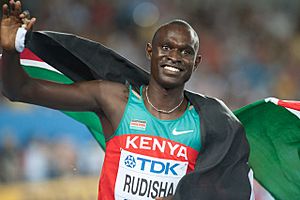
Kenya has been very strong in women's volleyball in Africa. The women's team has competed in the Olympics and World Championships. Cricket is also popular, and Kenya's team has played in the Cricket World Cup since 1996. They reached the semi-finals in 2003.
Rugby is growing in popularity, especially with the yearly Safari Sevens tournament. The Kenya Sevens team won a World Series championship in 2016. Kenya was once a strong football team in the region, but internal problems led to a suspension by FIFA.
In motor rallying, Kenya hosts the famous Safari Rally, known as one of the toughest rallies in the world. It was part of the World Rally Championship for many years and returned in 2021.
Nairobi has hosted major sports events, including the 1993 FIBA Africa Championship, where Kenya's national basketball team finished in the top four.
Kenya also has its own ice hockey team, the Kenya Ice Lions. Their home is the Solar Ice Rink in Nairobi, which is the first and largest ice rink in Africa.
Kenyan Food and Meals
Kenyans usually eat three meals a day: breakfast (kiamsha kinywa), lunch (chakula cha mchana), and supper (chakula cha jioni or chajio). They also have tea breaks at 10 AM and 4 PM. Breakfast often includes tea or porridge with bread, chapati, mahamri, boiled sweet potatoes, or yams.
Githeri is a common lunch dish in many homes. Ugali with vegetables, sour milk (mursik), meat, fish, or other stews is a popular meal for lunch or supper for many people. There are also different dishes depending on the region.
In western Kenya, among the Luo, fish is a common dish. Among the Kalenjin, who live in the Rift Valley, mursik (sour milk) is a popular drink.
In cities like Nairobi, you can find fast-food restaurants such as Steers, KFC, and Subway. There are also many fish-and-chips shops.
Cheese is becoming more popular in Kenya, especially among the middle class.
Images for kids
-
The Kenya–Uganda Railway near Mombasa about 1899
-
Kenya's third president, Mwai Kibaki
-
A Köppen climate classification map of Kenya
See also
 In Spanish: Kenia para niños
In Spanish: Kenia para niños




